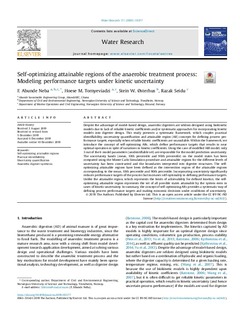| dc.contributor.author | Neba, Fabrice Abunde | |
| dc.contributor.author | Tornyeviadzi, Hoese M. | |
| dc.contributor.author | Østerhus, Stein Wold | |
| dc.contributor.author | Seidu, Razak | |
| dc.date.accessioned | 2020-01-22T10:07:48Z | |
| dc.date.available | 2020-01-22T10:07:48Z | |
| dc.date.created | 2019-12-10T22:18:42Z | |
| dc.date.issued | 2020 | |
| dc.identifier.citation | Water Research. 2020, 171 . | nb_NO |
| dc.identifier.issn | 0043-1354 | |
| dc.identifier.uri | http://hdl.handle.net/11250/2637434 | |
| dc.description.abstract | Despite the advantage of model-based design, anaerobic digesters are seldom designed using biokinetic models due to lack of reliable kinetic coefficients and/or systematic approaches for incorporating kinetic models into digester design. This study presents a systematic framework, which couples practical identifiability, uncertainty quantification and attainable region (AR) concepts for defining process performance targets, especially when reliable kinetic coefficients are unavailable. Within the framework, we introduce the concept of self-optimizing ARs, which define performance targets that results in near optimal operation in spite of variations in kinetic coefficients. Using the case of modified Hill model, only 3 out of the 6 model parameters (unidentifiable set) are responsible for the model prediction uncertainty. The uncertainty bands (mean, 10th percentile and 90th percentile) on the model states has been computed using the Monte Carlo Simulation procedure and attainable regions for the different levels of uncertainty has been constructed and the boundaries interpreted into digester structures. The self-optimizing attainable regions have been defined as the intersection region of the attainable regions corresponding to the mean, 10th percentile and 90th percentile. Incorporating uncertainty significantly reduces performance targets of the process but increases self-optimality in defining performance targets. Unlike the attainable region, which represents the limits of achievability for defined kinetics, the self-optimizing attainable region represents the set of all possible states attainable by the system even in cases of kinetic uncertainty. In summary, the concept of self-optimizing ARs provides a systematic way of defining process performance targets and making economic decisions under conditions of uncertainty. | nb_NO |
| dc.language.iso | eng | nb_NO |
| dc.publisher | Elsevier | nb_NO |
| dc.rights | Attribution-NonCommercial-NoDerivatives 4.0 Internasjonal | * |
| dc.rights.uri | http://creativecommons.org/licenses/by-nc-nd/4.0/deed.no | * |
| dc.title | Self-optimizing attainable regions of the anaerobic treatment process: Modelling performance targets under kinetic uncertainty | nb_NO |
| dc.type | Journal article | nb_NO |
| dc.type | Peer reviewed | nb_NO |
| dc.description.version | publishedVersion | nb_NO |
| dc.source.pagenumber | 16 | nb_NO |
| dc.source.volume | 171 | nb_NO |
| dc.source.journal | Water Research | nb_NO |
| dc.identifier.doi | 10.1016/j.watres.2019.115377 | |
| dc.identifier.cristin | 1759077 | |
| dc.description.localcode | Open Access. This article is available under the Creative Commons CC-BY-NC-ND license and permits non-commercial use of the work as published, without adaptation or alteration provided the work is fully attributed. | nb_NO |
| cristin.unitcode | 194,64,93,0 | |
| cristin.unitcode | 194,64,91,0 | |
| cristin.unitname | Institutt for havromsoperasjoner og byggteknikk | |
| cristin.unitname | Institutt for bygg- og miljøteknikk | |
| cristin.ispublished | true | |
| cristin.fulltext | original | |
| cristin.qualitycode | 2 | |

